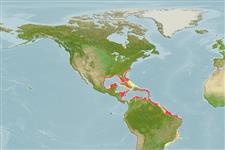Echinoidea |
Spatangoida |
Brissidae
Environment: milieu / climate zone / depth range / distribution range
Ecology
Benthic; brackish; depth range 13 - 72 m (Ref. 86574). Tropical
Western Central Atlantic.
Length at first maturity / Size / Weight / Age
Maturity: Lm ? range ? - ? cm
This species are found in a mud field within the lagoon. They live buried in 0.04 to 0.1 meters of mud. It takes them approximately 10 minutes to bury beneath the surface (Ref. 86574).
Life cycle and mating behavior
Maturity | Reproduction | Spawning | Eggs | Fecundity | Larvae
Members of the class Echinoidea are gonochoric. Fertilization is external. Brooding is common, eggs are held either on the peristome, around the periproct or deep into the concavities on the petaloids. Life cycle: Embryos develop into planktotrophic larvae (echinoplateus) and live for several months before they sink to the bottom using their tube feet to adhere on the ground where they metamorphose into young urchins.
Hendler, G. and D.L. Pawson 2000 Echinoderms of the Rhomboidal Cays, Belize: Biodiversity, distribution, and ecology. Atoll Research Bulletin 479:275-299. (Ref. 86570)
IUCN Red List Status
(Ref. 130435: Version 2025-1)
CITES status (Ref. 108899)
Not Evaluated
Not Evaluated
Threat to humans
Human uses
| FishSource |
Tools
More information
Trophic EcologyFood items (preys)
Diet composition
Food consumption
Predators
Population dynamicsGrowth
Max. ages / sizes
Length-weight rel.
Length-length rel.
Length-frequencies
Mass conversion
Abundance
Life cycleReproductionMaturityFecunditySpawningEggsEgg developmentLarvae PhysiologyOxygen consumption
Human RelatedStamps, coins, misc.
Internet sources
Estimates based on models
Preferred temperature
(Ref.
115969): 23.4 - 27.9, mean 26.5 (based on 188 cells).
Price category
Unknown.
